We independently evaluate all recommended products and services. Any products or services put forward appear in no particular order. If you click on links we provide, we may receive compensation.

Some EDC enthusiasts turn their noses up at Gerber products. I’ve been guilty of this as much as anyone else – while I really liked the Sedulo and Fastball (with some caveats), the Asada Micarta was a huge letdown. However, after carrying and reviewing the Center Drive Plus, I became more interested in Gerber’s multitool lineup, because they’re not afraid to try some funky ideas out on their multitools. While I’m a Leatherman guy through and through when it comes to mulititools, Leatherman really is more iterative than innovative – they’re figured out their formula and they mostly stick to it, and when they deviate it’s usually not a home run (like the Tread, or the whole magnet-based Free series which has been almost universally panned by Leatherman fans.)
Gerber has no such constraint, willing to put out really weird stuff – like the Mullet, a keychain tool that looks like a dude with a mullet, the Armbar which looks like half a multitool (with a fold-out bit driver), the Prybrid X (which is a box cutter on one end and a pry tool on the other), and the Devour – which they refer to as a “multi-fork.” So the weirdness of the Lockdown Pry and Drive should be no surprise, which can be kindly described as melted chocolate bars with tools pressed into them. They’re weird. They’re not perfect (spoiler alert) but they’re pretty cool pieces of design that might be just the thing you need depending on what you’re doing.
Since both tools are fairly similar, I’ll be reviewing both simultaneously and comparing the different and similar features they both possess. Both are priced identically at ~$45.
Gerber Center-Drive Plus
10
5.7 oz
2.5″
4.0″
N/A
China
Primary Implements
Each version of the Lockdown has four primary implements that fold out from the body via a thumb stud and lock in place with a liner lock, as well as some secondary implements built into the body itself. Some of the primary implements are shared: the Pry and Drive both feature a 2.5” long plain edge blade, a large file with a sharpened chisel end, and a replaceable #11 X-Acto blade. The difference between the two is that the Pry has a pair of scissors, while the Drive has an awl.
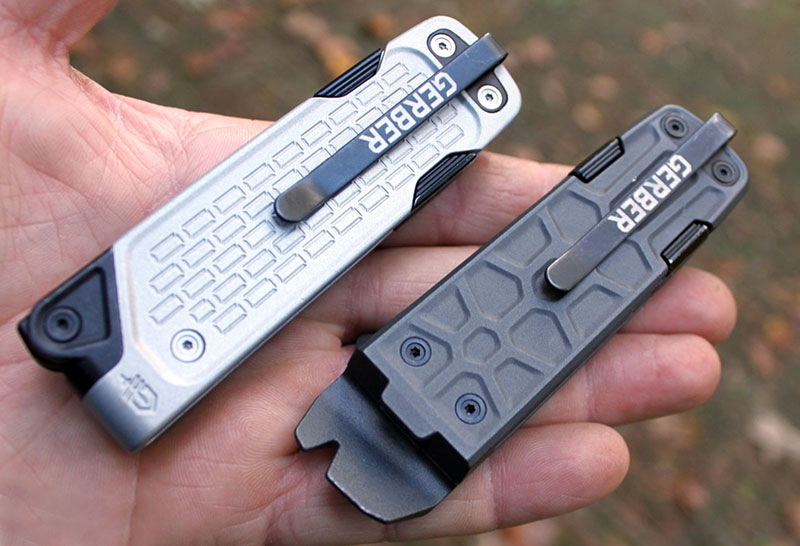
All four implements on each tool are accessed with a rectangular shaped thumb stud, and each tool locks in place with a regular liner lock. On the Pry, all the tools are black coated, while the Drive has plain satin finish on the tools.
The blade on both versions has a sabre grind (a short primary bevel with a large flat at the top) and a pretty extraordinarily wide edge grind. Not ideal geometry for slicing as it makes the blades very thick behind the edge. Both feature a neatly executed circular choil that terminates the edge very cleanly, as well as a stamped serial number on the blade (the same on both of my review samples, so maybe a part number) but no marking of any steel type. In fact, none of Gerber’s specifications on these tools make mention of any material types, so it’s pretty safe to assume it’s not any sort of high-end steel.

If the slicing geometry of the plain blade doesn’t suit you, there’s a super sharp replaceable blade opposite of it, a standard size X-Acto hobby blade which you can find replacements for easily (they’re currently $23 for a hundred of them on Amazon at time of writing) with a supremely sharp needle point. The X-Acto #11 is your standard replaceable art knife, so the inclusion of a much sharper and more needle-pointed cutting implement balances out the chunky primary blade.
Both versions also feature a large metal file, which is single cut (coarse) on one side and cross cut (fine) on the other, and both have an angled chisel tip at the end for scraping things. On the Pry the file is black coated, which I’m not sure really helps the purpose of a file, but I’m not an engineer.
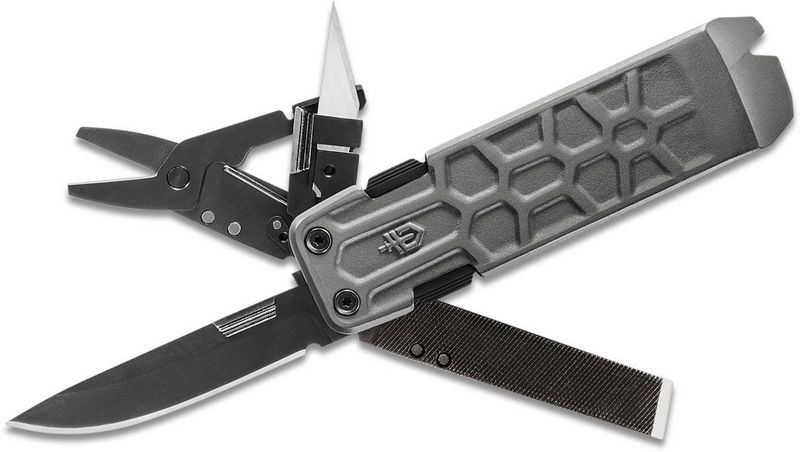
Finally we get to where the tools differ- the fourth tool on the Drive is an awl, and the fourth tool on the Pry is a pair of sprung scissors. I think the inclusion of the awl on the Drive model is for space constraints – if you compare the two side by side you’ll see the space used in the Pry to store the scissors (they’re stored splayed open 180 degrees) is taken up in the Drive by the bit driver tool, and the awl is considerably shorter. The awl is chisel ground with a very pointy tip but the edge isn’t sharpened like it is on some Swiss Army knives, but it does come down to a fairly narrow angle. After googling “what do you use an awl for” I can confidently tell you that an awl is generally used for putting holes in materials like leather. This one doesn’t feature a stitching hole, but as we’ll get to later, that wouldn’t work anyway.
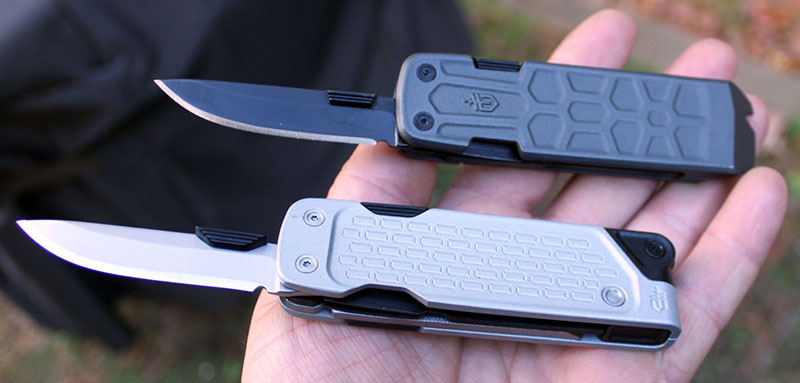
The Scissors on the Pry are a much more useful item in my eyes. They also deploy via thumb stud, and then you fold them into position the opposite direction you opened them until the moving arm rests against the spring. It’s a simple torsion spring that actuates them, and they’re pretty robust, with more leverage than cutting length. There’s a rolled over flat edge that serves as a thumb pad on the moving arm.
Secondary Implements
The secondary implements are what really differentiate these two models – the Pry’s secondary tools are part of the body, while the Drive’s is another fold-out implement. On the Pry, the body is lengthened at the end, and it includes a pry tool with small and large straight screw drivers (like the Shard), a nail puller, and of course a bottle opener. The Drive has a fold-out ¼” hex bit driver, which includes a two sided bit that’s a #2 Phillips on one end and a medium straight on the other. The driver is a slipjoint with a soft half-stop for extra leverage.
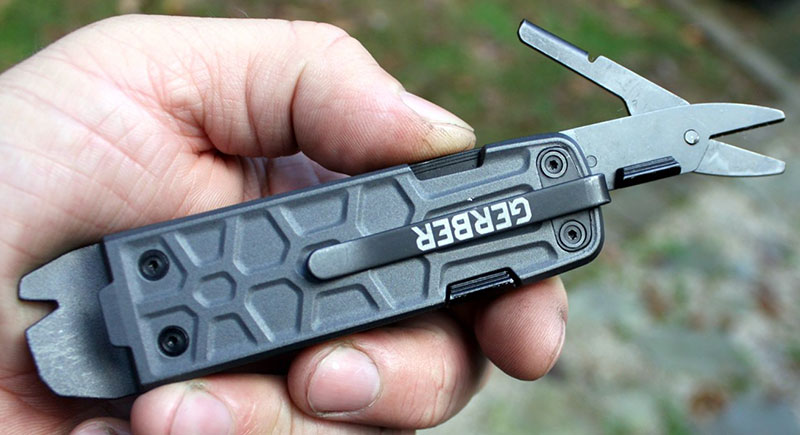
Features, Fit & Finish
Both versions of the Lockdown feature the same pocket clip, a bent steel spring clip that’s properly deep carry, attached to the body with two horizontal screws and located in a milled relief that helps to prevent the clip from rotating. It’s a really good pocket clip, surprising for a multitool, a genre that tends to suffer from a lack of pocket clips or a ‘who cares’ half-baked attempts. It’s got a shallow entry angle so it doesn’t drag on stuff, good tension, it sits pretty flat so it doesn’t interfere with your hand – and of course it’s got the Gerber branding on it.
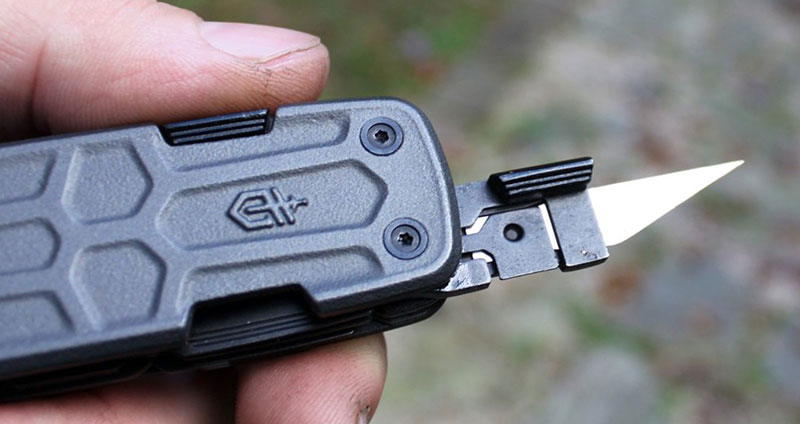
The body on both models is similar – flat plates of anodized aluminum, but both have slightly different patterns milled into them. The Pry has a wider honeycomb pattern complete with a larger Gerber logo opposite the clip side, anodized a dark greenish-grey, while the Drive is a silver-grey with a smaller brick pattern in the scales. Of course they’re also slightly different shapes, the Pry being a little longer thanks to the implements built into the end (Gerber says 4” closed for the Pry versus 3.87” for the Drive) as well as a little heavier (5.7 ounces versus 4.5 ounces, although the weight difference doesn’t feel that big in hand.)
We do have to talk about fit and finish though, which is a mixed bag. The actual aluminum bodies of both tools are nice, with fine machining details and an even anodizing treatment all around. They feel solid and expensive in hand until you actually take a look at the primary implements in the tools. The edge grind on the blades are some of the absolute sloppiest, steepest, most uneven, asymmetrical, tapered, ugliest grinds I’ve ever seen on a blade, and I’m a man that owns multiple Leatherman tools. They are quite sharp out of the box, but these are some of the ugliest grinds I’ve ever witnessed. In fact, the chisel grind on the end of both files is much nicer and more even than the blade grinds. Very odd.
Field Test
Both tools carry very well for multi-tools. That’s a big caveat, but most multitools are super unpleasant to have in your pocket, even my perennial favorite the Leatherman Skeletool CX is heavy, pointy in a bunch of places, and has a pretty mediocre pocket clip. But these are flat, smooth, not too huge, and have good pocket clips.

The biggest negative to both versions is deployment. I like the streamlined look of the thumb studs fitted tightly against the scales, but it makes it borderline impossible to open some of the tools one-handed even with the thumb stud. With nowhere to actually get your thumb pad on the back side of the thumb stud, you’re sometimes forced to actually use a thumbnail to dig the tools open. Combine this with unnecessarily stiff detents on all the tools, and they’re quite difficult to actually open.
One Youtuber (MaxLvlEDC) solved this by using a dremel tool to cut scallops in the scale to allow better access to the thumb studs, as well as disassembling the tool and bending the liner locks backwards to relieve some of the detent pressure. These are clever and well executed modifications, which will void your warranty, and shouldn’t be necessary on a new tool in the first place. Also worth noting is that the detents on my Drive model were softer than the Pry model, although hard to tell if this is intentional or not. You are obviously advised to be careful with all of your tools, but I managed to cut my thumb open while opening the blade on the Drive the first time I used it, when it slid off the thumb stud and onto the sharpened edge during deployment. I’ve been understandably reticent about one hand opening the blades ever since, and I’m someone who fiddles with folders as a replacement for a fidget spinner all day.
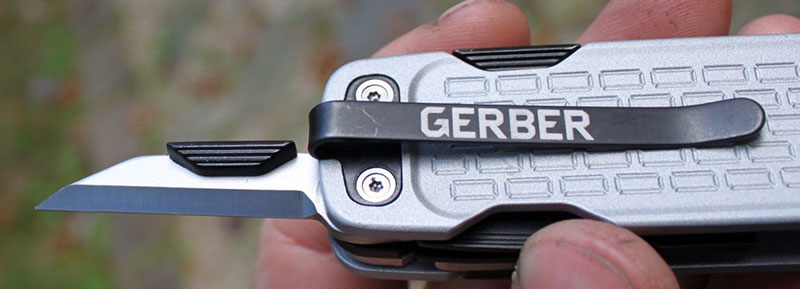
Those same thumb studs also present another issue: they take up a lot of real estate on the relatively small tools. On some implements this doesn’t matter (like the scissors, where they’re not in the way, and you can actually use it as a thumb pad) but it basically ruins the functionality of other tools. Like the file, the whole purpose of which is to use the surface as an abrasive, and a quarter of the single cut surface is taken up by the thumb stud. It’s not like you can use the area below it. Perhaps most useless is the awl on the Drive, which was a tool I always thought was useless anyway, which is rendered basically pointless with a thumb stud that doubles the width of a tool designed to put holes in things. No such problem with the replaceable blade, at least.
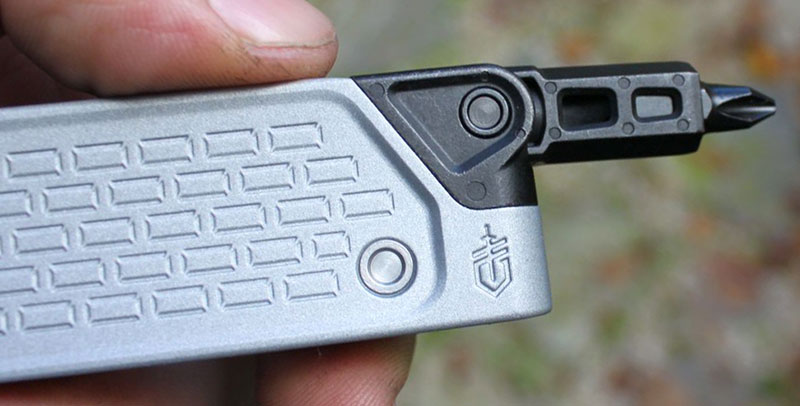
As far as the secondary implements, the namesakes of the tools themselves – actually quite good. The Pry is a darn good bottle opener, with plenty of space between the leverage and the hook so you can actually get it on a cap easily (a common issue with multitool bottle openers) and plenty of leverage. The pry tool ends fit nicely under the lid of a can of paint, and having the whole body of the tool as leverage is more than enough. If you need even more leverage it’s possible to open the file up and use the chisel end, effectively doubling the amount of force, as the file is pretty thick. I generally think the thing missing from multitools is a good pry tool, and here it’s built into the bones. The Drive is no slouch either, although the driver is a bit tricky to access. But it snaps in place with a fairly strong slipjoint, and it’s always nice to see a universal driver versus proprietary hardware that limits your options should you decided to use more specific bits for your use case. I do think the half-stop could be more well-defined (which you’d use to apply more torque to whatever you’re turning). The magnet retention in the driver is a nice touch as well.
Alternatives
All these knives available at BladeHQ.
The Lockdown Pry and Drive are pretty strange tools, which you’d think have no natural competition in the market, but the equally strange Leatherman Free T-series seems like an apt comparison, especially the larger Free T4. It’s also an oddly shaped multitool, a single body with implements that fold out of both sides, including a large plain edge blade, a file, a package opener/pry tool, a pair of sprung scissors, a 3D Phillips driver, and an awl – as well as a hidden pair of tweezers. The advantage of the Free over the Lockdown is the easy one-handed operation, thanks to a magnetic detent system. All tools lock in place and use a shared locking mechanism on each side, making it a good bit easier to open and close than the Lockdown. It’s pretty light at 4.3 ounces, but the chunky nature makes it a little uncomfortable in the pocket – although a deep carry clip helps. The T4 is a little more expensive than the Lockdown models, ringing in at $70, although there’s a cheaper Free T2 that’s a one-sided tool at a more reasonable $50.
SOG doesn’t make anything in the weird form-factor of the Lockdown, but the Powerpint and Powerliter are both very compact yet feature-dense folding multitools. The Powerliter weighs only 4.6 ounces and is small enough to pocket carry (thanks to a pocket clip) but manages to pack 17 tools into its small frame, including a set of compound-leverage pliers, a corkscrew with a separate leverage arm to properly pull a cork, a hidden ¼” hex bit driver, and a full complement of secondary implements inside, including a knife and a pair of sprung scissors and a package cutter. A neat tool, especially for the $69 MSRP.
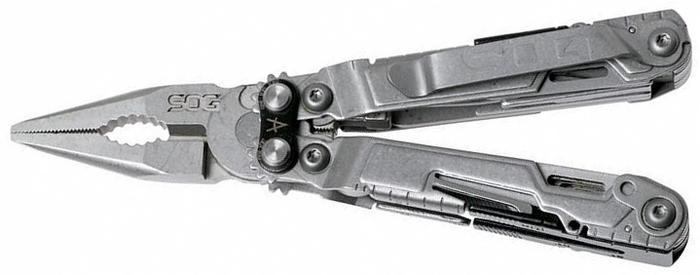
Of course, a lot of what the Lockdown twins accomplish can be partially covered by the trusty Victorinox Pioneer X Alox. The X model was an update to the Pioneer a few years ago which added a pair of sprung scissors, in addition to the regular Pioneer’s large plain blade, sharpened awl, bottle opener/wire stripper/large screwdriver, and can opener/small screwdriver toolset which has been a favorite of SAK fans for many years. It’s everything you need and nothing you don’t, and at $57 and 3.3 ounces it’s not heavy in your pocket or on your wallet. No locking tools, but I will say that the Victorinox bottle opener is still my favorite way to open a beer, even after all these years.
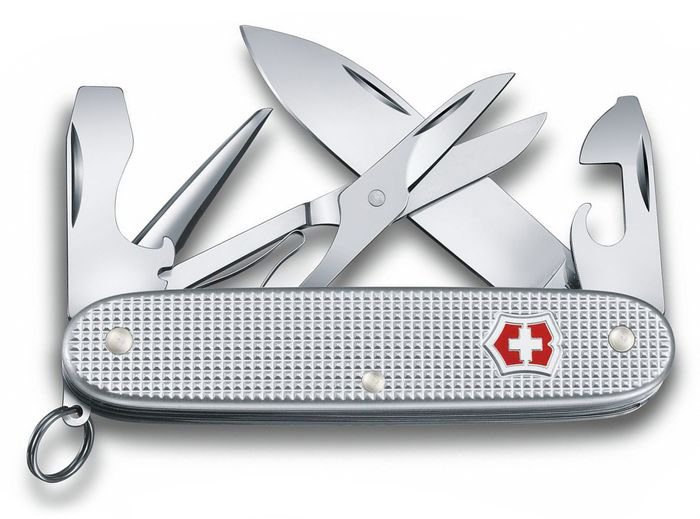
Wrap-Up
I really love that Gerber continues to make weird, innovative multitools. I like the form factor of both versions of the Lockdown, even if I think they could be improved in a few ways. The biggest problem is that they’re just plain hard to open, with nowhere to get a good grip on the thumb studs and way too much detent. I do also think the focus on the toolsets is too cutting-centric, with the Pry offering you a knife, a smaller knife, scissors, and a file with a chisel. Between the two of them, I found myself using the Pry much more often, as it has scissors and a bottle opener, two of my more frequently used implements. But either works for a light, pocketable around-the-house carry multitool.
- Unique form factor, a multitool that easily pocket carries, effective secondary implements on both tools, exchangeable x-acto blades, all primarily tools lock in place
- Very hard to deploy tools, thumb studs are in the way of actually using the tools, toolsets could be more broad use, fit and finish issues
Gerber Lockdown Pry Drive
Quality/Performance - 60%
Value for Money - 70%
65%
The Lockdown Drive and Pry are clever multitool ideas from Gerber but with imperfect execution.





